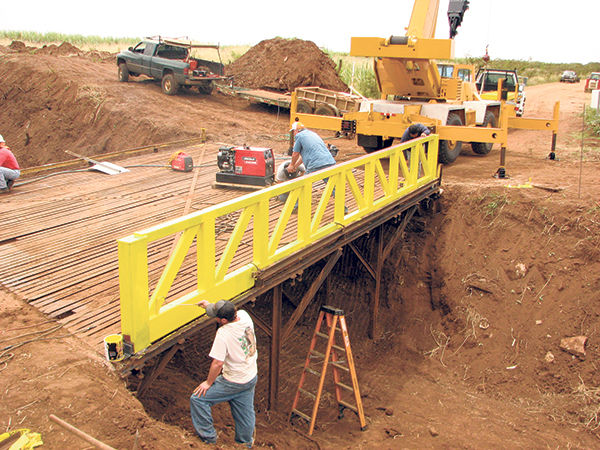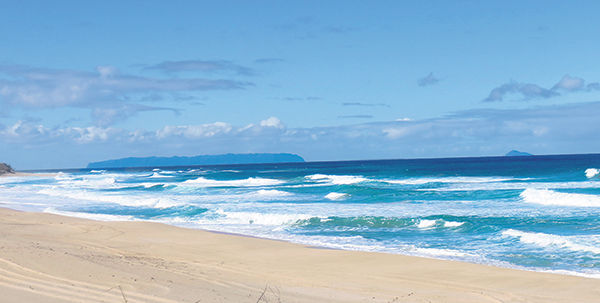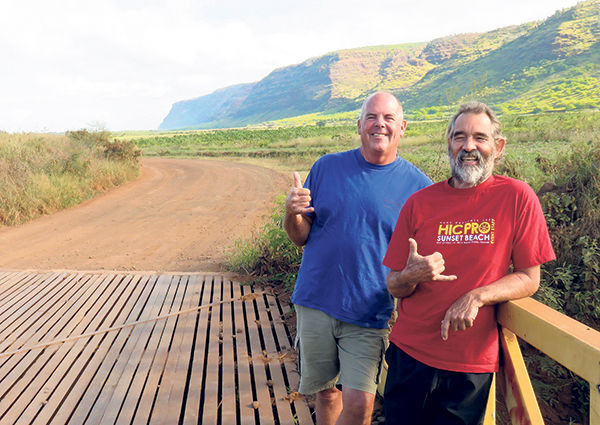Kauai people don’t take “no” for an answer — especially when state government shuts down the only access road to a favorite beach and surf spot indefinitely, not only telling the public it will be a minimum of two years
Kauai people don’t take “no” for an answer — especially when state government shuts down the only access road to a favorite beach and surf spot indefinitely, not only telling the public it will be a minimum of two years before repairs will be made, but making it illegal for people to traverse that road even by bicycle or on foot.
That’s what happened in 2008, when a torrential rainstorm completely washed away a portion of the four-mile unpaved access road to Polihale State Park on Kauai’s Westside, leaving a 10-foot hole that no vehicle could navigate.
State of Hawaii Department of Land and Natural Resources (DLNR) personnel told the public that it would take at least two years and $2 million to $4 million to reopen the road to the pristine seven-mile white sand beach.
Finding that unacceptable, dedicated Polihale surfers Bruce Pleas and Andy Johnston spearheaded an effort for members of the Kauai community to do the work themselves.
From start to finish, an all-volunteer force of Kauai contractors and surfers, using donated machinery, completed the repairs in 10 days.
Willing to help out
“What spurred us on was that the government made it illegal for anyone to go on the road to Polihale,” even by bicycle or on foot, Pleas says. “They were threatening to arrest people who went out there.”
During one of several meetings that the DLNR held for the public of Kauai, “Andy got up and said, ‘We’ll do it. We already know guys who can do the work,’ “ Pleas says. “At first the state said ‘No,’ but we knew we could do it.”
Johnston called KKCR, Kauai’s listener-funded community radio station, and laid out the scenario on the air, what the DLNR had decreed, and that a volunteer effort to repair the road was being proposed.
The moment Johnston finished talking with KKCR, his phone rang. It was Myron Lindsey, who had moved to Kauai from the Big Island.
“He said, ‘Hey Andy, I know how to do this stuff. I’m a road builder. I can probably free up some tractors,’” Johnston recalls.
Next, Johnston called his good friend, surfing buddy and excavation contractor Nick Prieto, who immediately said, “I’m in. When do we start?”
People started coming out of the woodwork, contractors calling other contractors. Within a week or two “we had a whole crew of guys chomping at the bit to fix the place,” Johnston recalls. “They had the tractors and the know-how to do it.”
“Polihale is a magical place. It’s one of the most beautiful beaches on theentire planet,” Johnston says.
“Everyone was willing to help.”
At first the DLNR declined the Kauai public’s help. But once they saw the viable solutions that the community had created, officials agreed.
Sunrise to sunset
There were about 25 companies that volunteered equipment and about 40 individuals who gave their time, Pleas says.
Food for the volunteers work force was donated by more than a dozen Westside eateries and individuals, “who were stoked we were doing the work,” Johnston says. “In most cases, before the words were out of my mouth, they’d say, ‘How many people will you have and what do you want to eat?’”
The crew “worked from sunrise to sunset,” Pleas says. “My friend, Val Badua, graded the entire road himself and was the main person in contact with Goodfellow Bros., a large general contractor that donated a grader and a water truck. Val has decades of experience with roads and projects such as this and made a huge difference.”
Volunteers also cleaned the bridge on the access road that was adjacent to the huge hole, inspected it for cracks and found it was in great shape.
“The man who designed and built the bridge in the 1950s or 1960s said it was the cleanest the bridge had ever been,” Pleas says.
Martin Steel donated massive iron safety railings for the bridge and dropped them into place with their crane, welded them and painted them “safety yellow.”
DLNR engineers told the volunteer work force that the bridge needed to be able to hold six tons of weight. No problem.
“When Martin Steel drove their 20-ton crane over it, we took a photo,” Pleas says. “I said, ‘Here, give this to your engineers. We already tested it.’”
“From the time we started talking about doing the work ourselves until the time we were done was about two months. The actual work took us only 10 days.”
Meaning of ‘community’
Word of this tremendous community collaboration spread far and wide. Kauai was featured on CNN; Rush Limbaugh lauded the effort, and the example our community set has been used since then by a Pepperdine University professor of public policy as a shining example of community leadership.
Pleas accepts the acknowledgements on behalf of everyone who worked on the project, but deflects personal accolades.
“Andy and I are not important,” he says. “The people who are important are the people who donated their time, their labor, their equipment and food.”
Johnston agrees and points out that this type of willingness on Kauai to help out is not unique to surfers or to the rebuilding of the road to Polihale. He says there are heroes all over this island who do volunteer work every day, such as in youth sports, volunteering for Kauai Hospice or Kauai United Way.
“There is a community spirit on Kauai that definitely comes out in times of need. It’s the true meaning of the word ‘community,’” he says. “You put that many people together and things get done. It’s a good feeling.”
•••
Pamela Varma Brown is the publisher of the book “Kauai Stories,” that includes the story of Kauai people working together to reopen the road to Polihale, and the forthcoming “Kauai Stories 2.”




